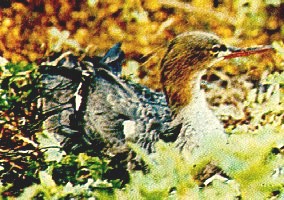 Synonyms: None.
Synonyms: None.Mergus serrator (Linnaeus, 1758)
 Synonyms: None.
Synonyms: None.
Common names: Engl: Red-breasted merganser; Russ: Krokhal' dlinnonosiy; Rom: Ferestras; Turk: Sutlabi; Ukr: Krokhal' dovgonosy.
Order (Scientific): ANSERIFORMES.
Family (Scientific): ANATIDAE.
Taxonomic descriptions: NB - numerous, CB - common.
 IUCN
Status:
IUCN
Status:
World level:
Black Sea Regional level:
Subregion level: VU (Ukraine sector)
Distribution:
Habitats type, Critical habitats, Limiting factors: An inhabitant of brackish shallow waters and salinas. Breeding habitats include islands and spits with dense (sometimes thinned out) grass. Coastal reed-beds are preferred. Feeding habitats are deep areas of bays and sea.
Biology: Mergus serrator is a partly resident species in the Black Sea Region. Breeding terms are late. Despite the early display and fighting of the males, starting from the end of March, the first nest scrapes appear only by the end of April, clutches are laid at the end of May and can be found till mid July. Incubation takes 30-32 days. Nests are made in the reed-beds (up to 43.3%) or growths of Frosted Orach (Atripex tatarica) and other shore vegetation. The species shows a strong nesting conservatism: some females may breed in the same locations annually. A usual clutch size varies within 16-22 eggs, the larger clutches of 16-22 are either mixed or laid by two females. Hatching begins in the second ten days of June, fall brooding - from the third ten days of June. Unfledged juveniles can be found till the second ten days of October. Can normally breed anew after clutch loss. Then the clutch size is reduced to 5-8 eggs. Breeding habitats are often destroyed by flues, which may wipe off parts of the shore. In cold winters Mergus serrator of the Black Sea origin occur in the Aegean Sea on the Greek shore. Probably, part of the population also winters in the Balkans, where they concentrate in large numbers, but it has not yet been confirmed by the ringing data. Usually birds leave their wintering grounds in early March. Mergus serrator are typical ichtyophagi (gobies of the family Gobiidae constitute their basic diet). Only chicks forage on the copepods and aquatic insects.
Population trends: In the past the species was never found in large numbers. Now it has become common, and even numerous in some locations (islands of Tendra Bay).
Threats: Reduction in breeding habitats, water pollution and a decrease in food, nest predation by Yellow-legged Gull.
Conservation measures taken: The species is protected in the "Chernomorski" and "Krymski" reserves.
Conservation measures proposed: Stopping the ongoing eutrophication of the sea bays, strengthening of the protection regime in the "Chernomorski" reserve, increasing public awareness.
References:
Compiled by: T.Ardamatzkaia.